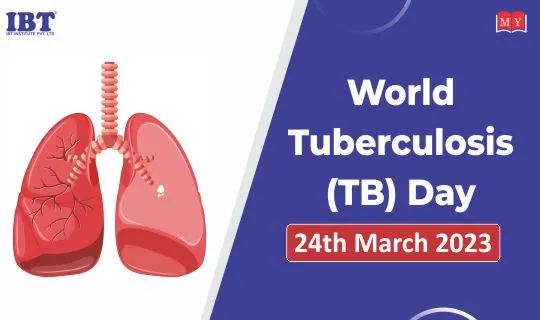
World Tuberculosis (TB) Day
World Tuberculosis Day, observed on 24 March each year, is designed to build public awareness about the global epidemic of tuberculosis (TB) and efforts to eliminate the disease. In 2018, 10 million people fell ill with TB, and 1.5 million died from the disease, mostly in low and middle-income countries. This also makes it the leading cause of death from an infectious disease.
World TB Day is one of eleven official global public health campaigns marked by the World Health Organization (WHO), along with World Health Day, World Chagas Disease Day, World Blood Donor Day, World Antimicrobial Awareness Week, World Immunization Week, World Malaria Day, World No Tobacco Day, World Hepatitis Day, World Patient Safety Day and World AIDS Day.
Theme: Yes! We can end TB!
History:
In 1982, on the one-hundredth anniversary of Robert Koch's presentation, the International Union Against Tuberculosis and Lung Disease (IUATLD) proposed that 24 March be proclaimed an official World TB Day. This was part of a year-long centennial effort by the IUATLD and the World Health Organization (WHO) under the theme "Defeat TB: Now and Forever.”World TB Day was not officially recognized as an annual occurrence by WHO's World Health Assembly and the United Nations until over a decade later.
In the fall of 1995, WHO and the Royal Netherlands Tuberculosis Foundation (KNCV) hosted the first World TB Day advocacy planning meeting in The Hague, Netherlands; an event they would continue co-sponsor over the next few years.In 1996, WHO, KNCV, the IUATLD, and other concerned organizations joined to conduct a wide range of World TB Day activities.
For World TB Day 1997, WHO held a news conference in Berlin during which WHO Director-General Hiroshi Nakajima declared that "DOTS is the biggest health breakthrough of this decade, according to lives we will be able to save." WHO's Global TB Programme Director, Dr. Arata Kochi, promised that "Today the situation of the global TB epidemic is about to change, because we have made a breakthrough. It is the breakthrough of health management systems that makes it possible to control TB not only in wealthy countries but in all parts of the developing world, where 95 percent of all TB cases now exist."
By 1998, nearly 200 organizations conducted public outreach activities on World TB Day. During its World TB Day 1998 news conference in London, WHO for the first time identified the top twenty-two countries with the world's highest TB burden. The next year, over 60 key TB advocates from 18 countries attended the three-day WHO/KNCV planning meeting for World TB Day 1999.
U.S. President Bill Clinton marked World TB Day 2000 by administering the WHO-recommended Directly Observed Therapy, Short-Course (DOTS) treatment to patients at the Mahavir Hospital in Hyderabad, India. According to Clinton, "These are human tragedies, economic calamities, and far more than crises for you, they are crises for the world. The spread of disease is the one global problem for which ... no nation is immune."
In Canada, the National Collaborating Centre for Determinants of Health noted on World TB Day 2014 that 64% of TB cases reported nationally were among foreign-born individuals and 23% among Aboriginal people, highlighting TB as a key area of concern about health equity.
Today the Stop TB Partnership, a network of organizations and countries fighting TB (the IUATLD is a member and WHO houses the Stop TB Partnership secretariat in Geneva), organizes the Day to highlight the scope of the disease and how to prevent and cure it.
 4.5/5
4.5/5








